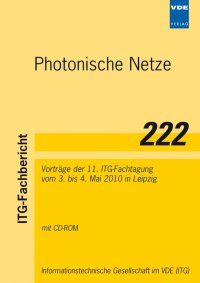InP-basierte elektrische und elektro-optische Komponenten für 112 Gb/s OOK Systeme
Conference: Photonische Netze - 11. ITG-Fachtagung
05/03/2010 - 05/04/2010 at Leipzig, Germany
Proceedings: Photonische Netze
Pages: 7Language: englishTyp: PDF
Personal VDE Members are entitled to a 10% discount on this title
Authors:
Schubert, C.; Bach, H.-G.; Mekonnen, G. G.; Zhang, R.; Ludwig, R.; Schmidt-Langhorst, C. (Fraunhofer Institut für Nachrichtentechnik, Heinrich-Hertz-Institut (HHI), Einsteinufer 37, 10587 Berlin)
Makon, R. E.; Driad, R. (Fraunhofer Institut für Angewandte Festkörperphysik (IAF), Tullastr. 72, 79108 Freiburg)
Steffan, A. G. (u2t Photonics AG, Reuchlinstrasse 10/11, 10553 Berlin)
Abstract:
The development of transmission technology for 100G long-haul transmission systems is mainly concentrated on systems with low symbol rate (up to about 50 Gbaud) in conjunction with higher-order modulation formats (e.g. QPSK) and coherent detection. These systems provide a high spectral efficiency and robustness against transmission impairments. For short-reach systems or future long-haul systems with higher data rates (400 Gb/s or above), the use of higher symbol rates (100 Gbaud or higher) is of interest. Such systems have comparably simple transmitter and receiver architectures, which could result in cost-efficient realizations. However, this is only true if compact and integrated solutions for the key-components (optical-to-electrical-, electrical-to-optical-conversion, electrical amplification and processing) are found at such high symbol rates. Within the European funded projects HECTO and GIBON, such key-components, based on InP technology, have been realized over the past 3 to 3.5 years. In this paper, we report on the application of the InP-based components developed in HECTO and GIBON, in particular the receiver components, in system experiments up to 112 Gb/s OOK. The investigated components are: 1) a high-speed photoreceiver (up to 112 Gb/s), comprising a photodiode and a traveling-wave amplifier, monolithically integrated on a single chip; 2) a bias-feeding photodetector with high bandwidth (90 GHz), which can be adapted to the subsequent electronic components by a variable output DC level and 3) a CDR-module, developed by the Fraunhofer IAF, which enables simultaneous electrical 1:2 demultiplexing and clock recovery up to 112 Gb/s. We show measurements of eye diagrams and bit error ratios up to 112 Gb/s.


